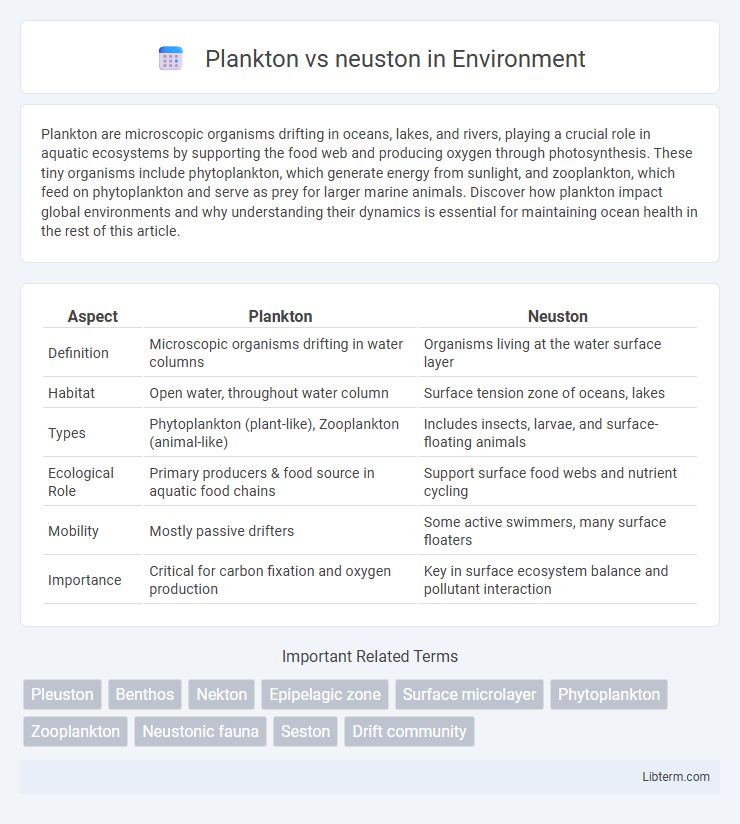Plankton are microscopic organisms drifting in oceans, lakes, and rivers, playing a crucial role in aquatic ecosystems by supporting the food web and producing oxygen through photosynthesis. These tiny organisms include phytoplankton, which generate energy from sunlight, and zooplankton, which feed on phytoplankton and serve as prey for larger marine animals. Discover how plankton impact global environments and why understanding their dynamics is essential for maintaining ocean health in the rest of this article.
Table of Comparison
| Aspect | Plankton | Neuston |
|---|---|---|
| Definition | Microscopic organisms drifting in water columns | Organisms living at the water surface layer |
| Habitat | Open water, throughout water column | Surface tension zone of oceans, lakes |
| Types | Phytoplankton (plant-like), Zooplankton (animal-like) | Includes insects, larvae, and surface-floating animals |
| Ecological Role | Primary producers & food source in aquatic food chains | Support surface food webs and nutrient cycling |
| Mobility | Mostly passive drifters | Some active swimmers, many surface floaters |
| Importance | Critical for carbon fixation and oxygen production | Key in surface ecosystem balance and pollutant interaction |
Introduction to Plankton and Neuston
Plankton comprises microscopic organisms drifting in the water column, including phytoplankton and zooplankton, playing a critical role in aquatic food webs and global carbon cycling. Neuston refers to organisms inhabiting the surface film of seas and freshwater bodies, adapting to the air-water interface environment for feeding and reproduction. Understanding the ecological roles and distribution of plankton and neuston is essential for marine biology and ecosystem monitoring.
Definition and Classification
Plankton consists of microscopic organisms drifting in water columns, including phytoplankton (photosynthetic) and zooplankton (heterotrophic), classified based on size and trophic behavior. Neuston refers to organisms living at the air-water interface, encompassing both flora and fauna adapted to surface tension and classified into epineuston (surface dwellers) and hyponeuston (just below the surface). Both groups play crucial roles in aquatic ecosystems, but differ distinctly in their habitat positioning and physiological adaptations.
Key Differences Between Plankton and Neuston
Plankton encompasses a broad range of microscopic organisms drifting in water columns, including phytoplankton and zooplankton, critical for aquatic food webs. Neuston specifically refers to organisms living at the air-water interface, often including insects, spiders, and some algae that float or swim near the surface tension. The key difference lies in habitat: plankton inhabit various depths within water, while neuston occupy the surface film, creating distinct ecological niches and adaptations.
Habitat and Distribution
Plankton primarily inhabit the pelagic zone, drifting freely in the ocean's water column across various depths, from surface waters to deep seas, and are distributed globally, often concentrated in nutrient-rich areas like upwelling zones. Neuston organisms occupy the ocean's surface microlayer, a unique habitat at the air-water interface where they exploit abundant light and organic matter, with distribution linked closely to calm, open waters such as tropical and subtropical regions. Both groups contribute significantly to marine ecosystems but exhibit distinct spatial niches shaped by their habitat preferences and physical adaptations.
Morphological Adaptations
Plankton exhibit diverse morphological adaptations such as streamlined bodies, elongated appendages, and transparent exoskeletons that enhance buoyancy and reduce predation in open water. Neuston organisms display specialized surface tension adaptations like hydrophobic hairs and flattened or air-trapping structures to maintain buoyancy and mobility at the air-water interface. These morphological traits optimize survival and resource acquisition within their distinctly different ecological niches.
Ecological Roles and Functions
Plankton and neuston both play critical roles in aquatic ecosystems by supporting food webs and nutrient cycling. Plankton, including phytoplankton and zooplankton, serve as primary producers and key food sources for various marine organisms, driving carbon fixation and oxygen production. Neuston organisms inhabit the water surface layer, facilitating the transfer of energy between aquatic and atmospheric systems while providing habitat and food for surface-dwelling species.
Importance in Aquatic Food Webs
Plankton and neuston play critical roles in aquatic food webs by serving as foundational primary producers and primary consumers, respectively. Plankton, including phytoplankton and zooplankton, contribute significantly to global carbon cycling and oxygen production, supporting higher trophic levels such as fish and marine mammals. Neuston organisms, residing at the air-water interface, provide a unique habitat and nutrient source for diverse species, facilitating energy transfer between marine and atmospheric ecosystems.
Threats and Environmental Challenges
Plankton face significant threats from ocean acidification and rising sea temperatures, which disrupt their calcium carbonate structures and reproductive cycles, respectively. Neuston communities are highly vulnerable to plastic pollution and chemical runoff accumulating at the ocean surface, impairing their ability to thrive and serve as a critical link in marine food webs. Both plankton and neuston populations are adversely affected by habitat loss due to coastal development and increasing ultraviolet radiation caused by ozone depletion.
Plankton and Neuston in Climate Regulation
Plankton, including phytoplankton and zooplankton, play a crucial role in climate regulation by sequestering carbon dioxide through photosynthesis and forming the base of marine food webs that support carbon cycling. Neuston, the ecosystem at the ocean surface, contributes to climate regulation by facilitating gas exchange between the atmosphere and ocean, influencing heat retention and carbon flux. Both plankton and neuston significantly impact global carbon cycles and help mitigate climate change by maintaining oceanic carbon sinks.
Future Research and Conservation Efforts
Future research on plankton and neuston ecosystems emphasizes high-resolution remote sensing and molecular techniques to map biodiversity and understand species interactions across oceanic surface layers. Conservation efforts prioritize reducing plastic pollution and mitigating climate change impacts to preserve these critical communities that regulate carbon cycling and marine food webs. Integrating ecological modeling with experimental data enhances predictions of plankton and neuston responses to environmental stressors, guiding adaptive marine protected area management.
Plankton Infographic

 libterm.com
libterm.com